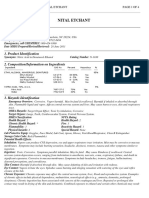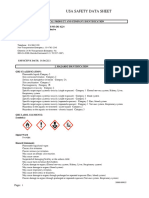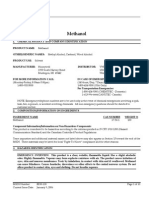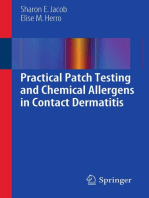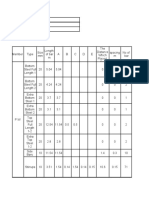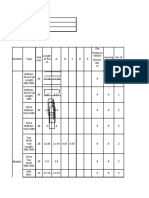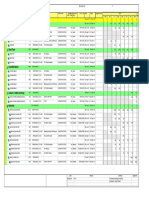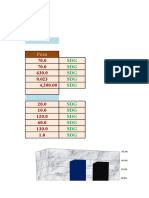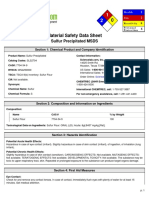MSDS English
MSDS English
Uploaded by
Führer Magdi BadranCopyright:
Available Formats
MSDS English
MSDS English
Uploaded by
Führer Magdi BadranCopyright
Available Formats
Share this document
Did you find this document useful?
Is this content inappropriate?
Copyright:
Available Formats
MSDS English
MSDS English
Uploaded by
Führer Magdi BadranCopyright:
Available Formats
Methanol
MATERIAL SAFETY DATA SHEET
This Material Safety Data Sheet (MSDS) complies with the United Nations Globally Harmonized
System (GHS) of Classification and Labeling, Second revised Edition and meets or exceeds the
Canadian and United States Requirements for Hazard Communication
1. Product and Supplier Identification
Product Name: Methanol
GHS Product Identifier: Methanol
Recommended Use: Solvent, fuel, feedstock
Restrictions on Use: Do not use in a confined area without proper ventilation. Contact lenses
may cause further damage in case of splash into eye. Avoid use near heat, flames, sparks, and
other sources of ignition.
Product: Methanol (CH3OH) Methanex Tel. #: (604) 661-2600
Synonyms: Methanol, methyl hydrate, wood Emergency Tel. #: 1-800-262-8200
spirit, methyl hydroxide (CHEMTREC) (Canada and USA)
Company Methanex Corporation
Identification: 1800 Waterfront Centre
200 Burrard Street
Vancouver, B.C.
V6C 3M1
Importer: Methanex Methanol Company
15301 Dallas Parkway, Suite 900
Addison, Texas 75001
Telephone: (972) 702-0909
2. Hazards Identification
Classification: Flammable Liquid, Category 1, Acute Toxicity Category 1*, Reproductive
Toxicity 1B, Specific Target Organ Toxicity (Repeated Exposure)
Label:
Hazard Communication: DANGER! Extremely flammable liquid and vapour. Fatal if swallowed.
May damage fertility or the unborn child (fetotoxic and teratogenic effects).
May cause damage to eyes and central nervous system if ingested or inhaled.
*Note: Assigned to classification based on human experience rather than the strict application of
classification criteria set out in the Recommendations on the Transport of Dangerous Goods, Model
Regulations Special Provision 279.
Hazards: Colourless liquid, with a mild, characteristic alcohol odour when pure. Crude methanol may have a
repulsive, pungent odour. Hygroscopic (moisture absorbing).
FLAMMABLE LIQUID AND VAPOUR: Burns with a clean, clear flame, which is almost invisible in daylight,
or a light blue flame. Can decompose at high temperatures forming carbon monoxide and formaldehyde.
Methanex Corporation -1- September 22, 2008
Methanol
Confined space toxicity hazard. Mild central nervous system depressant following inhalation, skin absorption
or ingestion. May cause headache, nausea, dizziness, drowsiness, and un-coordination. Severe vision
effects, including increased sensitivity to light, blurred vision, and blindness may develop following an 8-24
hour symptom-free period. Coma and death may result.
IRRITANT: Causes eye irritation. Aspiration hazard. Swallowing or vomiting of the liquid may result in
aspiration (breathing) into the lungs.
POSSIBLE REPRODUCTIVE HAZARD: May cause fetotoxic (toxic to the fetus during the latter stages of
pregnancy, often through the placenta) and teratogenic effects (causing malformations of the fetus), based
on animal information.
NFPA Ratings: (Health, Fire, Reactivity): 1, 3, 0
3. Composition
Component % (w/w) Exposure Limits LD50 LC50
(ACGIH)*
Methanol 99-100 ACGIH* TLV-TWA: 200 ppm, skin; 5628 mg/kg 64000 ppm
(CAS 67-56-1) TLV-STEL: 250 ppm, skin (oral/rat) (inhalation/rat)
PEL-TWA: 200 ppm, skin
PEL-STEL: 250 ppm, skin 15800 mg/kg
IDLH: 6000 ppm, acute inhalation (dermal/
toxicity to animals rabbit)
TLV Basis, critical effects: neuropathy,
vision, central nervous system(CNS)
* Exposure limits may vary from time to time and from one jurisdiction to another. Check with local regulatory
agency for the exposure limits in your area. ACGIH, American Conference of Governmental Industrial
Hygienists.
4. First Aid Measures
Note: Emergency assistance may also be available from the local poison control centre.
Eye Contact: Remove contact lenses if worn. In case of contact, immediately flush eyes with plenty of clean
running water for at least 15 minutes, lifting the upper and lower eyelids occasionally. Obtain medical
attention.
Skin Contact: In case of contact, remove contaminated clothing. In a shower, wash affected areas with
soap and water for at least 15 minutes. Seek medical attention if irritation occurs or persists. Wash clothing
before reuse. Prolonged contact with methanol may defat skin tissue, resulting in drying and cracking.
Inhalation: Remove to fresh air, restore or assist breathing if necessary. Obtain medical attention.
Ingestion: Swallowing methanol is potentially life threatening. Onset of symptoms may be delayed for 18 to
24 hours after digestion. If conscious and medical aid is not immediately available, do not induce vomiting.
In actual or suspected cases of ingestion, transport to medical facility immediately.
NOTE TO PHYSICIAN: Acute exposure to methanol, either through ingestion or breathing high airborne
concentrations can result in symptoms appearing between 40 minutes and 72 hours after exposure.
Symptoms and signs are usually limited to the Central Nervous System (CNS), eyes and gastrointestinal
tract. Because of the initial CNS’s effects of headache, vertigo, lethargy and confusion, there may be an
impression of ethanol intoxication. Blurred vision, decreased acuity and photophobia are common
complaints. Treatment with ipecac or lavage is indicated in any patient presenting within two hours of
ingestion. A profound metabolic acidosis occurs in severe poisoning and serum bicarbonate levels are a
Methanex Corporation -2- September 22, 2008
Methanol
more accurate measure of severity than serum methanol levels. Treatment protocols are available from
most major hospitals and early collaboration with appropriate hospitals is recommended.
Ethanol significantly decreases the toxicity of methanol because it competes for the same metabolic
enzymes, and has been used to treat methanol poisoning.
5. Fire Fighting Measures
Suitable Extinguishing Media: Extinguishing Media: Small fires: Dry chemical, CO2, water spray
Large fires: Water spray(see note in Unsuitable Extinguishing Media), AFFF(R) (Aqueous Film Forming
Foam (alcohol resistant)) type with either a 3% or 6% foam proportioning system.
Unsuitable Extinguishing Media: General purpose synthetic foams or protein foams may work, but much
less effectively. Water may be effective for cooling, but may not be effective for extinguishing a fire because
it may not cool methanol below its flash point.
Specific Hazards: Methanol vapours may burn with an invisible flame. During a fire, carbon monoxide,
carbon dioxide and irritation and toxic gases such as formaldehyde may be generated. Vapours can
accumulate in confined spaces resulting in a toxicity and flammability hazard. Closed containers may rupture
violently and suddenly release large quantities of methanol when exposed to fire or excessive heat for a
sufficient period of time. Vapours are slightly heavier than air and may travel long distances toward sources
of ignition.
Hazardous Combustion Products: Toxic gases and vapours; oxides of carbon and formaldehyde.
Fire Fighting Instructions: Methanol burns with a clean clear flame that is almost invisible in daylight. Stay
upwind! Isolate and restrict area access. Concentrations of greater that 25% methanol in water can be
ignited. Use fine water spray or fog to control fire spread and cool adjacent structures or containers. Contain
fire control water for later disposal. Fire fighters must wear full face, positive pressure, self-contained
breathing apparatus or airline and appropriate protective fire fighting clothing as per NFPA. Note that
methanol fires may require proximity suits. Take care not to walk through any spilled chemical.
Special Information: Vapours can flow along surfaces to distant ignition sources and flash back.
6. Accidental Release Measures
Overview: Flammable liquid! Can burn without a visible flame. Release can cause an immediate risk of fire
and explosion. Eliminate all ignition sources, stop leak and use absorbent materials. If necessary, contain
spill by diking. Fluorocarbon alcohol resistant foams may be applied to spill to diminish vapour and fire
hazard. Maximize methanol recovery for recycling or re-use. Restrict access to area until completion of
cleanup. Ensure cleanup is conducted by trained personnel only. Wear adequate personal protection and
remove all sources of ignition. Notify all governmental agencies as required by law.
Personal Protection: Full face, positive pressure self-contained breathing apparatus or airline, and fire
resistant protective clothing with chemical resistant splash suit must be worn. If product ignites, approach
and fire fighting must be done with appropriate fire fighting clothing.
Environmental Precautions: Biodegrades easily in water. Methanol in fresh or salt water may have
serious effects on aquatic life. A study on methanol’s toxic efffects on sewage sludge bacteria reported little
effect on digestion at 0.1% while 0.5% methanol retarded digestion. Methanol will be broken down to carbon
dioxide and water.
Remedial Measures: Flammable liquid. Release can cause an immediate fire/explosion hazard. Eliminate
all sources of ignition, stop leak and use absorbent materials. Collect liquid with explosion proof pumps. Do
not walk through spill product as it may be on fire and not visible.
Small Spills: Soak up spill with non-combustible absorbent material. Recover methanol and dilute with
water to reduce fire hazard. Prevent spilled methanol from entering sewers, confined spaces, drains, or
waterways. Restict access to unprotected personnel. Put material in suitable, covered, labeled containers.
Flush area with water.
Methanex Corporation -3- September 22, 2008
Methanol
Large Spills: If necessary, contain spill by diking. Fluorocarbon alcohol resistant foams may be applied to
spill to diminish vapour and fire hazard. Maximize methanol recovery for recycling or reuse. Collect liquid
with explosion proof pumps.
7. Handling and Storage
Precautions for Handling: No smoking or open flame in storage, use or handling areas. Use explosion
proof electrical equipment. Ensure proper electrical grounding procedures are in place.
Storage: Store in totally enclosed equipment, designed to avoid ignition and human contact. Tanks must be
grounded, vented, and should have vapour emission controls. Tanks must be diked as per NFPA or API
Standards. A flammable mixture of methanol vapour and air is possible inside a storage tank or
transportation tank, and handlers should take appropriate precautions to reduce the risk of ignition. Handlers
must eliminate ignition sources or purge the tank with an inert gas such as nitrogen. All equipment must be
grounded - bonded when transferring product in order to avoid static discharge from the equipment, and
subsequent possible fire. Avoid storage with incompatible materials. Anhydrous methanol is non-corrosive
to most metals at ambient temperatures except for lead, nickel, monel, cast iron and high silicon iron.
Coatings of copper (or copper alloys), zinc (including galvanized steel), or aluminum are unsuitable for
storage. These materials may be attacked slowly by the methanol. Storage tanks of welded construction are
normally satisfactory. They should be designed and built in conformance with good engineering practice for
the material being stored. While plastics can be used for short term storage, they are generally not
recommended for long-term storage due to deterioration effects and the subsequent risk of contamination.
Corrosion rates for several construction materials:
<0.508 mm/year: Cast iron, monel, lead, nickel
<0.051 mm/year: High silicon iron
Some attack: Polyethylene
Satisfactory: Neoprene, phenolic resins, polyesters, natural rubber, butyl rubber
Resistant: Polyvinyl chloride, unplasticized
8. Exposure Controls, Personal Protection
Occupational Controls: ACGIH* TLV-TWA: 200 ppm, skin (262 mg/m3);
TLV-STEL: 250 ppm, skin (328 mg/m3);
PEL-TWA: 200 ppm, skin
PEL-STEL: 250 ppm, skin
TLV Basis: critical effects: neuropathy, vision,
central nervous system(CNS)
IDLH: 6000 ppm, acute inhalation toxicity to animals
Engineering Controls: In confined areas, local and general ventilation should be provided to maintain
airborne concentrations below permissable exposure limits. Ventilation systems must be designed according
to approved engineering standards.
Respiratory Protection: NIOSH/OSHA recommendations for methanol concentrations in air:
Up to 2000 ppm: supplied air respirator
Up to 5000 ppm: supplied air respirator operated in a continuous-flow mode.
Up to 6000 ppm: supplied air respirator with a tight-fitting facepiece operated in a continuous- flow
mode; or Full-facepiece self-contained breathing apparatus or Full-facepiece supplied air respirator.
Cartridge type respirators are NOT recommended.
Emergency or Planned entry into unkown concentrations or IDLH (immediately dangerous to life or health)
conditions:
Methanex Corporation -4- September 22, 2008
Methanol
Respirator selection must be done by a qualified person and be based upon a risk assessment of the work
activities and exposure levels. Respirators must be fit tested and users must be clean shaven where the
respirator seals to the face. Exposure must be kept at or below the applicable exposure limits and the
maximum use concentration of the respirator must not be exceeded.
Positive pressure, full-facepiece self-contained breathing apparatus; or Positive pressure, full-facepiece
supplied air respirator with an auxiliary positive pressure self-contained breathing apparatus.
Skin Protection: Butyl and nitrile rubbers are recommended for gloves. Check with manufacturer. Wear
chemical resistant pants and jackets, preferably of butyl or nitrile rubber. Check with manufacturer.
Eye and Face Protection: Face shield and chemical splash goggles when transferring is taking place.
Contact lenses should not be worn when working with methanol.
Footwear: Chemical resistant and as specified by the workplace.
Other: Eyewash and showers should be located near work areas. NOTE: PPE must not be considered a
long-term solution to exposure control. PPE usage must be accompanied by employer programs to properly
select, maintain, clean, fit and use. Consult a competent industrial hygiene resource to determine hazard
potential and/or the PPE manufacturers to ensure adequate protection.
Careful consideration must be made of the added danger of the concenentration being in the LEL/UEL
range and so there may be a fire/explosion hazard.
9. Physical and Chemical Properties
Appearance: Liquid, clear, colourless Upper Explosive Limit (UEL): 36.5 %
Odour: Mild characteristic alcohol odour Lower Explosive Limit (LEL): 6%
Odour Threshold: detection: 4.2 - 5960 ppm Auto Ignition Temperature: 464°C
(geometric mean) 160 ppm Solvent Solubility: Soluble in all proportions in
recognition: 53 – 8940 ppm ethanol, benzene, other alcohols, chloroform,
(geometric mean) 690 ppm diethyl ether, other ethers, esters, ketones and
pH: Not applicable most organic solvents
Freezing Point: -97.8°C Critical Temperature: 239.4°C
Boiling Point: 64.7°C Specific Gravity: 0.791 @ 20°C
Boiling Range: Not determined Evaporation Rate: 4.1 (n-butyl acetate =1)
Flash Point: 11.0oC Vapour Density: 1.105 @ 15°C (air = 1)
Solubility: Completely soluble Decomposition Temperature: Not determined
Partial Coefficient: Log P (oct) = -0.82 Sensitivity to Impact: No
Vapour Pressure: 12.8 kPa @ 20°C Sensitivity to Static Charge: Low
10. Stability and Reactivity
Chemical Stability: Stable as supplied.
Hazardous Reactions: Yes. Avoid contact with strong oxidizers, strong mineral or organic acids, and strong
bases. Contact with these materials may cause a violent or explosive reaction. May be corrosive to lead,
aluminum, magnesium, and platinum.
Conditions to Avoid: Avoid contact with sparks, heat, open flame, or ignition sources.
Incompatibility: Yes. Avoid contact with strong oxidizers, strong mineral or organic acids, and strong
bases. Contact with these materials may cause a violent or explosive reaction. May be corrosive to lead,
aluminum, magnesium, and platinum. May react with metallic aluminum or magnesium and generate
hydrogen gas. May attack some forms of plastic, rubber, and coatings.
Hazardous Decomposition Products: Formaldehyde, carbon dioxide, and carbon monoxide.
Hazardous Polymerization: Will not occur.
Methanex Corporation -5- September 22, 2008
Methanol
11. Toxicological Information
Signal Word/Label: DANGER! Extremely flammable liquid and vapour. Fatal if swallowed.
May damage fertility or the unborn child (fetotoxic and teratogenic effects).
May cause damage to eyes and central nervous system if ingested or inhaled.
Primary Routes of Entry:
Skin Contact: Yes
Skin Absorption: Yes
Eye Contact: Yes
Ingestion: Yes
Inhalation: Yes
Emergency Overview: Colourless liquid, with a mild, characteristic alcohol odour when pure. Crude
methanol may have a repulsive, pungent odour. Hygroscopic. Can decompose at high temperatures forming
carbon monoxide and formaldehyde. Confined space toxicity hazard. Mild central nervous system
depressant following inhalation, skin absorption or ingestion. May cause headache, nausea, dizziness,
drowsiness, and incoordination. Severe vision effects, including increased sensitivity to light, blurred vision,
and blindness may develop following an 8-24 hour symptom-free period. Coma and death may result.
Causes eye irritation. Aspiration hazard. Swallowing or vomiting of the liquid may result in aspiration
(breathing) into the lungs. May cause fetotoxic (toxic to the fetus during the latter stages of pregnancy, often
through the placenta) and teratogenic effects (causing malformations of the fetus), based on animal
information.
Acute Exposure:
Inhalation: Inhalation of high airborne concentrations can also irriate mucous membranes, cause
headaches, sleepiness, nausea, confusion, loss of consciousness, digestive and visual disturbances and
even death. NOTE: Odour threshhold of methanol is several times higher than the TLV-TWA. Depending
upon severity of poisoning and the promptness of treatment, survivors may recover completely or may have
permanent blindness, vision disturbances and/or nervous system effects. Concentrations in air exceeding
1000 ppm may cause irritation of the mucous membranes.
Skin Contact: Methanol is moderately irritating to the skin. Methanol can be absorbed through the skin and
harmful effects have been reported by this route of entry. Effects are similar to those described in
“Inhalation”.
Eye Contact: Methanol is a mild to moderate eye irritant. High vapour concentration or liquid contact with
eyes causes irritation, tearing and burning.
Ingestion: Swallowing even small amounts of methanol could potentially cause blindness or death. Effects
of sub lethal doses may be nausea, headache, abdominal pain, vomiting and visual disturbances ranging
from blurred vision to light sensitivity.
Chronic Exposure:
Irritancy: Prolonged contact with skin may defat tissue causing dermititis or aggravate existing skin
problems.
Sensitization: None reported.
Methanex Corporation -6- September 22, 2008
Methanol
Carcinogenicity: Not listed by IARC, NTP, ACGIH, or OSHA as a carcinogen.
Teratogenicity: Methanol has produced fetotoxicity in rats and teratogenicity in mice exposed by
inhalation to high concentrations of methanol vapours .
Reproductive Toxicity: Information available does not suggest that methanol is a reproductive toxin.
Mutagenicity: There is insufficient information available to conclude that methanol is mutagenic.
Synergistic Products: In animals, high concentrations of methanol can increase the toxicity of other
chemicals, particularly liver toxins like carbon tetrachloride. Ethanol significantly reduces the toxicity of
methanol because it competes for the same metabolic enzymes, and has been usd to treat methanol
poisoning.
Potential for Accumulation: Methanol is readily absorbed into the body following inhalation and ingestion.
Skin absorption may occur if the skin is broken or exposure is prolonged. Once absorbed, methanol is
rapidly distributed to body tissues. A small amount is excreted unchanged in exhaled air and the urine. The
rest is first metabolized to formaldehyde, which is then metabolized to formic acid and/or formate. The formic
acid and formate are eventually converted to carbon dioxide and water. In humans, methanol clears from the
body, after inhalation or oral exposure, with a half-life of 1 day or more for high doses (greater than 1000
mg/kg) or about 1.5-3 hours for low doses (less than 100 mg/kg or 76.5-230 ppm (100-300 mg/m3)).
Medical Conditions Aggravated By Exposure: Persons with pre-existing skin disorders, eye problems,
respiratory conditions, or impaired liver or kidney functions may be more susceptable to the effects of this
substance.
12. Ecological Information
Environmental toxicity: DO NOT discharge into sewer or waterways.
Methanol:
LC50 Pimephales promelas (fathead minnows) 29.4 g/L/96 hr, (28-29 days old), confidence limit=
28.5-30.4; Test conditions: Water temp= 25°C, dissolved oxygen= 7.3 mg/L, water hardness= 43.5
mg/l CaCO3, alkalinity= 46.6 CaCO3, tank volume= 6.3 L, additions= 5.71 V/D, pH= 7.66
LC50 Pimephales promelas (Fathead minnow, 28-32 day old, 0.126 g) 29,700 mg/L/24 hr; flow-
through, 23.3+/-1.7°C, hardness 46.4 mg/L CaCO3, pH 7.0-8.0
LC50 Pimephales promelas (Fathead minnow, 30 day old 0.12 g) 28,100 mg/L/96 hr; flow-through, 24-
26°C, hardness 45.5 mg/L CaCO3, pH 7.5
LC50 Daphnia pulex (Water flea, <24 hr old) 19,500 mg/L/18 hr; static, 22°C, hardness 23+/-2
mg/L CaCO3
EC50 Daphnia obtusa (Water flea, <24 hr old; immobilization) 23,500 mg/L/24 hr; static, 20+/-2°C,
hardness 250 mg/L CaCO3, pH 7.8+/-0.2
EC50 Daphnia obtusa (Water flea, <24 hr old; immobilization) 22,200 mg/L/48 hr; static, 20+/-2°C,
hardness 250 mg/L CaCO3, pH 7.8+/-0.2
log Kow: -0.82 – -0.66
Half-life (hr) air: 427
Half-life (hr) H2O surface water: 5.3 – 64
3 -6
Henry’s Law constant (atm m /mol): 4.55X10
BOD 5 if unstated: 0.76 – 1.12
COD: 1.05 – 1.50, 99%
ThOD: 1.05
BCF: 0.2 – 10
TLm(48 hr): 8000mg/L (trout)
Toxicity Arthropoda: NOEL 10 g/L/48 hr (Daphnia)
HSNO Classification: 9.3C – Harmful to terrestrial vertebrates
Methanex Corporation -7- September 22, 2008
Methanol
Methanol in fresh or salt water may have serious effects on aquatic life. A study on methanol’s toxic effects
on sewage sludge bacteria reported little effect on digestion at 0.1% while 0.5% methanol retarded
digestion. Methanol will be broken down into carbon dioxide and water.
Environmental Fate:
Biodegradability: Biodegrades easily in water and soil.
Bioaccumulation:
• TERRESTRIAL FATE: Based on a classification scheme, an estimated Koc value of 1 determined
from a structure estimation method indicates that methanol is expected to have very high mobility in
soil. Volatilization of methanol from moist soil surfaces is expected to be an important fate process
given a Henry’s Law constant of 4.55X10-6 (atm m3/mol). The potential for volatilization of methanol
from dry soil surfaces may exist based upon a vapor pressure of 127 mm Hg. Biodegradation is
expected to be an important fate process for methanol.
• AQUATIC FATE: Based on a classification scheme, an estimated Koc value of 1, determined from
a structure estimation method, indicates that methanol is not expected to adsorb to suspended
solids and sediment. Volatilization from water surfaces is expected based upon a Henry's Law
-6 3
constant of 4.55X10 (atm m /mol). Using this Henry's Law constant and an estimation method,
volatilization half-lives for a model river and model lake are three and 35 days, respectively.
According to a classification scheme, a BCF of less than 10 measured in fish, suggests
bioconcentration in aquatic organisms is low. Hydrolysis and photolysis in sunlit surface waters is
not expected to be an important environmental fate process for methanol since this compound
lacks functional groups that hydrolyze or absorb light under environmentally relevant conditions.
Methanol has been shown to undergo rapid biodegradation in a variety of screening studies using
sewage seed and activated sludge inoculum, which suggests that biodegradation will occur in
aquatic environments.
• ATMOSPHERIC FATE: According to a model of gas/particle partitioning of semi volatile organic
compounds in the atmosphere, methanol, which has a vapor pressure of 127 mm Hg at 25°C, is
expected to exist solely as a vapor in the ambient atmosphere. Vapor-phase methanol is degraded
in the atmosphere by reaction with photo chemically-produced hydroxyl radicals; the half-life for this
reaction in air is estimated to be 17 days, calculated from its rate constant of 9.4X10-13 cu
cm/molecule-sec at 25°C
13. Disposal Considerations
Review federal, provincial or state, and local government requirements prior to disposal. Store material for
disposal as indicated in Section #7, Handling and Storage. Disposal by controlled incineration or by secure
land fill may be acceptable.
Recycle wherever possible. Large volumes may be suitable for re-distillation or, if contaminated,
incinerated. Can be disposed of in a sewage treatment facility. Methanol levels of up to 0.1% act as a food
source for bacteria; above this level may be toxic to bacteria. When pumping through sewage collection
systems, the level of methanol should be kept below the flammable range (a 25% methanol/water mixture is
non-flammable at temperatures below 39°C). 1 ppm of methanol is equivalent to 1.5 ppm BOD loading in
the sewage plant.
Container disposal:
Empty containers may contain hazardous residue. Return to supplier for reuse if possible. Never weld, cut
or grind empty containers. If disposing of containers, ensure they are well rinsed with water, then disposed
of at an authorised landfill. After cleaning, all existing labels should be removed.
Methanex Corporation -8- September 22, 2008
Methanol
14. Transport Information
Canada Transportation of Dangerous Goods (TDG): UN 1230, Methanol, Class 3(6.1),
P.G. II
Limited Quantity: ≤ 1 litres
ERG Guide Number: 131
United States Department of Transport (49CFR): UN 1230, Methanol, Class 3, P.G. II,
(Domestic Only) (RQ 5000 lbs/2270 kg)
Limited Quantity: ≤ 1 litres
ERG Guide Number: 131
International Air Transport Association (IATA): UN 1230, Methanol, Class 3(6.1), P.G. II
Packaging Instruction (passenger aircraft):
305, 1 litre maximum per package,
International Maritime Organization (IMO): UN 1230, Methanol, Class 3(6.1), P.G.II,
Flash Point = 11°C
EmS No. F-E, S-D
Stowage Category “B”, Clear of living
quarters
Marine Pollutant: No
15. Regulatory Information
CANADIAN FEDERAL REGULATIONS:
CEPA, DOMESTIC SUBSTANCES LIST: Listed (Canadian Environmental Protection Act
(CEPA) Schedule I)
WHMIS CLASSIFICATION: B2, D1B, D2A, D2B
UNITED STATES REGULATIONS:
29CFR 1910.1200 (OSHA): Hazardous
40CFR 116-117 (EPA): Hazardous
40CFR 355, Appendices A and B: Subject to Emergency Planning and Notification
40CFR 372 (SARA Title III): Listed
40CFR 302 (CERCLA): Listed
TOXIC SUBSTANCES CONTROL ACT (TSCA): Listed in the inventory.
16. Other Information
References:
1. International Programme on Chemical Safety, Methanol, Environmental Health Criteria, World
Health Organization 1997.
2. Patty’s Industrial Hygiene and Toxicology, 5th Edition.
3. Fire Protection Guide to Hazardous Materials, 13th Edition.
4. Lanigan, S., Final report on the Safety Assessment of Methyl Alcohol, International Journal of
Toxicology., Volume 20, Supplement 1 (2001).
5. Forsberg, K., Quick Selection Guide to Chemical Protective Clothing.
6. Nelson, B.K., Teratological assessment of Methanol and Ethanol at high inhalation levels in rats,
Fundamental and Applied Toxicology, Volume 5.
7. NIOSH Guide to Chemical Hazards
8. Hazardous Substance Data Base (HSDB).
9. Cheminfo.
Methanex Corporation -9- September 22, 2008
Methanol
Original Preparation Date: September 22, 2005
Prepared by: Kel-Ex Agencies Ltd., P.O. Box 52201, Lynnmour RPO, North Vancouver, B.C., Canada,
V7J 3V5
Disclaimer: The information above is believed to be accurate and represents the best information currently
available to us. Users should make their own investigations to determine the suitability of the information for
their particular purposes. This document is intended as a guide to the appropriate precautionary handling of
the material by a properly trained person using this product.
Methanex Corporation and its subsidiaries make no representations or warranties, either express or implied,
including without limitation any warranties of merchantability, fitness for a particular purpose with respect to
the information set forth herein or the product to which the information refers. Accordingly, Methanex Corp.
will not be responsible for damages resulting from use of or reliance upon this information.
This Material Safety Data Sheet may not be changed, or altered in any way without the expressed
knowledge and permission of Methanex Corporation
Revisions: Revised and re-issued in GHS Format September 22, 2008
Methanex Corporation - 10 - September 22, 2008
You might also like
- Material Safety Data Sheet: Product Name: ABRO Electronic Contact Cleaner Product Number/Size: EC-533Document5 pagesMaterial Safety Data Sheet: Product Name: ABRO Electronic Contact Cleaner Product Number/Size: EC-533Abraham Gomez Soto100% (2)
- Work Item ProductivityDocument85 pagesWork Item ProductivityShiham Sherifdeen89% (19)
- Methylated SpiritDocument7 pagesMethylated SpiritPiNo ratings yet
- MSDS Blockade 100 EC PDFDocument5 pagesMSDS Blockade 100 EC PDFDean Hadi WardanaNo ratings yet
- Silikometer ManualDocument147 pagesSilikometer ManualAhmad Adel El TantawyNo ratings yet
- Potassium Chloride MSDS: Section 1: Chemical Product and Company IdentificationDocument5 pagesPotassium Chloride MSDS: Section 1: Chemical Product and Company IdentificationHarry PasaribuNo ratings yet
- Material Safety Data Sheet: 1. Product and Supplier IdentificationDocument7 pagesMaterial Safety Data Sheet: 1. Product and Supplier IdentificationGeorge Van BommelNo ratings yet
- Methanol SdsDocument9 pagesMethanol SdsLeslieBigbearNo ratings yet
- Material Safety Data Sheet: 1. Product InformationDocument5 pagesMaterial Safety Data Sheet: 1. Product Informationsushant_jhawerNo ratings yet
- Methanol (Ch3oh) MsdsDocument7 pagesMethanol (Ch3oh) MsdssahilchemNo ratings yet
- Methanol (Ch3oh) MsdsDocument7 pagesMethanol (Ch3oh) Msdsmahaberani_zNo ratings yet
- Methanol: 1. Chemical Product and Emergency Telephone ContactDocument8 pagesMethanol: 1. Chemical Product and Emergency Telephone ContactMurli RamchandranNo ratings yet
- Msds MethanolDocument7 pagesMsds MethanolMerry PaembonanNo ratings yet
- MSDS MethanolDocument6 pagesMSDS MethanolAzran AzainiNo ratings yet
- SMC Material Safety Data Sheet MethanolDocument9 pagesSMC Material Safety Data Sheet Methanolanand.srajuNo ratings yet
- Usa Safety Data Sheet: LORD Corporation 111 LORD Drive Cary, NC 27511-7923 USADocument8 pagesUsa Safety Data Sheet: LORD Corporation 111 LORD Drive Cary, NC 27511-7923 USAJean Carlos MottaNo ratings yet
- Chemlok 205Document8 pagesChemlok 205edwinsk9No ratings yet
- Material Safety Data Sheet: PO Box 1182 New Canaan, CT 06840 Phone/fax - 800-853-1577Document9 pagesMaterial Safety Data Sheet: PO Box 1182 New Canaan, CT 06840 Phone/fax - 800-853-1577soliman fathyNo ratings yet
- Jet Fuel - SDS 941 - 130709 PDFDocument11 pagesJet Fuel - SDS 941 - 130709 PDFSUBHOMOYNo ratings yet
- Methanol MSDSDocument8 pagesMethanol MSDSgeverett2765No ratings yet
- Data Sheet - CHEMLOK 6108Document8 pagesData Sheet - CHEMLOK 6108t5j64yydrhNo ratings yet
- Nital - MSDSDocument4 pagesNital - MSDSJim2313No ratings yet
- Material Safety Data Sheet: ProductDocument12 pagesMaterial Safety Data Sheet: ProductOmar EzzatNo ratings yet
- Material Safety Data Sheet: TolueneDocument6 pagesMaterial Safety Data Sheet: TolueneRAJNo ratings yet
- Multex SDS GBR Ver. 03.00Document8 pagesMultex SDS GBR Ver. 03.00FBNo ratings yet
- MPCL840 (MSDS)Document5 pagesMPCL840 (MSDS)Hồng PhongNo ratings yet
- MIBKDocument8 pagesMIBKNovianti Nur RahmahNo ratings yet
- CHEMLOK 6224 Safety Data SheetDocument8 pagesCHEMLOK 6224 Safety Data Sheetgino.pontigoNo ratings yet
- Electroclean A Quick Dry PDFDocument8 pagesElectroclean A Quick Dry PDFCatalin SevastianNo ratings yet
- Msds Methanol BDHDocument10 pagesMsds Methanol BDHRohith KommuNo ratings yet
- Methanol MSDS PDFDocument10 pagesMethanol MSDS PDFPutriErvinaNo ratings yet
- Material Safety Data Sheet Toluene (MSDS)Document6 pagesMaterial Safety Data Sheet Toluene (MSDS)MilanNo ratings yet
- Material Safety Data Sheet: AcetoneDocument6 pagesMaterial Safety Data Sheet: AcetonefructoraNo ratings yet
- Material Safety Data Sheet: 2-PropanolDocument3 pagesMaterial Safety Data Sheet: 2-PropanolsalwajodyNo ratings yet
- Material Safety Data Sheet: TolueneDocument8 pagesMaterial Safety Data Sheet: TolueneJudyNo ratings yet
- Uc Msds Hempel UndercoatDocument5 pagesUc Msds Hempel UndercoatdfountoukidisNo ratings yet
- Clean R Carb Carburetor CleanerDocument6 pagesClean R Carb Carburetor CleanerNabeel maqsoodNo ratings yet
- Methanol MSDSDocument10 pagesMethanol MSDSRaja DhanasekaranNo ratings yet
- ButanolDocument7 pagesButanolNur Intan PratiwiNo ratings yet
- Cutback Asphalt MsdsDocument8 pagesCutback Asphalt MsdsAdib TawfiqNo ratings yet
- Safety Data Sheet: 1. IdentificationDocument15 pagesSafety Data Sheet: 1. IdentificationFelix Vejar ZepedaNo ratings yet
- MS-122AD Dry LubricantDocument6 pagesMS-122AD Dry LubricantAsrizal Tri Winaryo50% (2)
- WD-40 Aerosol MSDSDocument5 pagesWD-40 Aerosol MSDSTirto Dhanu RahmanNo ratings yet
- MSDS Phenol - CARBLICDocument4 pagesMSDS Phenol - CARBLICVikramNo ratings yet
- MS 122XDDocument7 pagesMS 122XDNICKYNo ratings yet
- High Тemp v2: Photoreactive Resin for Form 2Document8 pagesHigh Тemp v2: Photoreactive Resin for Form 2pnpexpertsNo ratings yet
- Affidabilità e Sicurezza 9Document2 pagesAffidabilità e Sicurezza 9Matteo BajoccoNo ratings yet
- Material Safety Data Sheet Dimethylglyoxime, 1% Alcoholic Section 1 - Chemical Product and Company IdentificationDocument7 pagesMaterial Safety Data Sheet Dimethylglyoxime, 1% Alcoholic Section 1 - Chemical Product and Company IdentificationRevi PutriNo ratings yet
- Isocyanate - SDSDocument10 pagesIsocyanate - SDSFadilla AzhariNo ratings yet
- MSDS Crude OilDocument6 pagesMSDS Crude OilFabio IkaczykNo ratings yet
- DichloromethaneDocument9 pagesDichloromethanelabopancamitraNo ratings yet
- MSDS Naftalena DafaDocument8 pagesMSDS Naftalena DafaMuhamad DafaNo ratings yet
- Safety Data Sheet Training FormDocument11 pagesSafety Data Sheet Training FormSaya LahNo ratings yet
- 1180 Epoxy White SDSDocument7 pages1180 Epoxy White SDSMohammed Absar HussainNo ratings yet
- Fosroc Nitoflor FC 130 and Nitoflor FC140 BaseDocument8 pagesFosroc Nitoflor FC 130 and Nitoflor FC140 Basearaka44No ratings yet
- Material Safety Data Sheet Tapmatic Dual Action Plus #1 Cutting FluidDocument10 pagesMaterial Safety Data Sheet Tapmatic Dual Action Plus #1 Cutting FluidKarl MakoyNo ratings yet
- Methylene Chloride: Safety Data SheetDocument5 pagesMethylene Chloride: Safety Data SheetAnuj Kumar Mishra100% (1)
- Material Safety Data Sheet: Section 1 X Product and Company IdentificationDocument5 pagesMaterial Safety Data Sheet: Section 1 X Product and Company Identificationomar benounaNo ratings yet
- Msds Ethanol (Ana)Document4 pagesMsds Ethanol (Ana)Claudia MmsNo ratings yet
- Practical Patch Testing and Chemical Allergens in Contact DermatitisFrom EverandPractical Patch Testing and Chemical Allergens in Contact DermatitisNo ratings yet
- Footing # of Item Length Width High F1 7 2.7 2.7 0.6 30.618 CF1 1 131.5 1.3 0.5 85.475 CF2 1 30 1.3 0.5 19.5 CF3 1 19.1 1 0.5 9.55 145.143Document9 pagesFooting # of Item Length Width High F1 7 2.7 2.7 0.6 30.618 CF1 1 131.5 1.3 0.5 85.475 CF2 1 30 1.3 0.5 19.5 CF3 1 19.1 1 0.5 9.55 145.143Führer Magdi BadranNo ratings yet
- 5 Quality Control of Concrete ProblemsDocument30 pages5 Quality Control of Concrete ProblemsFührer Magdi BadranNo ratings yet
- Shopdrawing BBS - COLUMNDocument7 pagesShopdrawing BBS - COLUMNFührer Magdi BadranNo ratings yet
- Shopdrawing BBS - SlabeDocument7 pagesShopdrawing BBS - SlabeFührer Magdi BadranNo ratings yet
- Shopdrawing BBS - P.WDocument5 pagesShopdrawing BBS - P.WFührer Magdi BadranNo ratings yet
- دليل تحليل أسعار أعمال البناء PDFDocument147 pagesدليل تحليل أسعار أعمال البناء PDFFührer Magdi BadranNo ratings yet
- CT-01 Monthly Project Cash FlowDocument1 pageCT-01 Monthly Project Cash FlowFührer Magdi BadranNo ratings yet
- Shopdrawing BBS - BeamsDocument9 pagesShopdrawing BBS - BeamsFührer Magdi BadranNo ratings yet
- Quantities in Bid PDFDocument2 pagesQuantities in Bid PDFFührer Magdi BadranNo ratings yet
- Costx 6.8 Release Notes: Headline FeaturesDocument17 pagesCostx 6.8 Release Notes: Headline FeaturesFührer Magdi BadranNo ratings yet
- Bid Form PDFDocument5 pagesBid Form PDFFührer Magdi BadranNo ratings yet
- Tracking ScheduleDocument1 pageTracking ScheduleFührer Magdi BadranNo ratings yet
- Resource ManagmentDocument1 pageResource ManagmentFührer Magdi BadranNo ratings yet
- Time Scedule Base LineDocument1 pageTime Scedule Base LineFührer Magdi BadranNo ratings yet
- جداول حساب الكمياتDocument9 pagesجداول حساب الكمياتFührer Magdi BadranNo ratings yet
- Pages From CCE Preparation AUC Chapter 8 AudioDocument9 pagesPages From CCE Preparation AUC Chapter 8 AudioFührer Magdi BadranNo ratings yet
- C - 6 - Slings SafetyDocument29 pagesC - 6 - Slings SafetyFührer Magdi BadranNo ratings yet
- Resource TrackingDocument2 pagesResource TrackingFührer Magdi BadranNo ratings yet
- تكلفة أعمال ومواد التشييدDocument75 pagesتكلفة أعمال ومواد التشييدFührer Magdi BadranNo ratings yet
- Date Work Type: Client: Location: Work Start at Work Finish @Document1 pageDate Work Type: Client: Location: Work Start at Work Finish @Führer Magdi BadranNo ratings yet
- HAZMAT Training PresentationDocument44 pagesHAZMAT Training PresentationReyNo ratings yet
- IKEA - Huntsman Positive List - 27 May 2016 - EN - FINAL - v1Document30 pagesIKEA - Huntsman Positive List - 27 May 2016 - EN - FINAL - v1Flávia DutraNo ratings yet
- United Chemicals Company: Cottage Air FreshenerDocument2 pagesUnited Chemicals Company: Cottage Air Freshenereng4008No ratings yet
- Complete Top-of-Wall Firestopping Solution!: CP 672 CP 672Document4 pagesComplete Top-of-Wall Firestopping Solution!: CP 672 CP 672Gökhan GülhanNo ratings yet
- Ardrox 8901W White Contrast Paint Safety Data Sheet 20200827Document10 pagesArdrox 8901W White Contrast Paint Safety Data Sheet 20200827Ken SidhartaNo ratings yet
- Gematilen FK - Lldpe MsdsDocument4 pagesGematilen FK - Lldpe MsdsKottathil OruthanNo ratings yet
- Product Identification and Manufacture Information.: Msds-1Document4 pagesProduct Identification and Manufacture Information.: Msds-1hse indacoNo ratings yet
- Termimesh TMA 725 MSDS January 2015Document5 pagesTermimesh TMA 725 MSDS January 2015sschkadeNo ratings yet
- Sulfur Precipitated MSDS: Section 1: Chemical Product and Company IdentificationDocument6 pagesSulfur Precipitated MSDS: Section 1: Chemical Product and Company IdentificationImma OlayanNo ratings yet
- Palmolive Dishwashing Liquid SDSDocument9 pagesPalmolive Dishwashing Liquid SDSNoe JimenezNo ratings yet
- Lexemul EGDS MBDocument7 pagesLexemul EGDS MBimam badruzmnNo ratings yet
- STEPGROWRM1002Document2 pagesSTEPGROWRM1002Alfredo MéndezNo ratings yet
- Ginger MsdsDocument6 pagesGinger MsdskokoNo ratings yet
- MSDS Coke and Coke BreezeDocument2 pagesMSDS Coke and Coke Breezekotaro minamiNo ratings yet
- 6.2 - Hsse Risk ManagementDocument27 pages6.2 - Hsse Risk ManagementNwekeNwokomaAugustineNo ratings yet
- B75 Boysen Silver Finish Aluminum PaintDocument8 pagesB75 Boysen Silver Finish Aluminum PaintTRUTH TV100% (2)
- TDS V-8439Document2 pagesTDS V-8439CuriosityShopNo ratings yet
- Trisodium Citrate SDS CCS 09092016 PDFDocument5 pagesTrisodium Citrate SDS CCS 09092016 PDFmeNo ratings yet
- Zinc Nitrate SDSDocument7 pagesZinc Nitrate SDSemeka2012No ratings yet
- MSDS Rheflat PlusDocument6 pagesMSDS Rheflat PlusJose AlejandroBlancoNo ratings yet
- Chess Insecticide MsdsDocument7 pagesChess Insecticide MsdsssangachonuerNo ratings yet
- Light Cycle OilDocument4 pagesLight Cycle OilAhmed Qani AlkurdiNo ratings yet
- Silco Af 889 PDFDocument1 pageSilco Af 889 PDFmarcela walterosNo ratings yet
- Stable Peroxide Substrate Buffer (1X)Document8 pagesStable Peroxide Substrate Buffer (1X)jaykishan1No ratings yet
- Student Guide Book Subject: Safety Health and Environmental Protection (ENGE ENGE600012)Document18 pagesStudent Guide Book Subject: Safety Health and Environmental Protection (ENGE ENGE600012)Selviya AvaurumNo ratings yet
- Material Safety Data Sheet: Brass Wire Brushes MSDS #12Document4 pagesMaterial Safety Data Sheet: Brass Wire Brushes MSDS #12LoveNo ratings yet
- Comfort Fabric Conditioner MSDS PDFDocument4 pagesComfort Fabric Conditioner MSDS PDFMark DunhillNo ratings yet
- Naphtha, VM&P MSDS: Section 1: Chemical Product and Company IdentificationDocument6 pagesNaphtha, VM&P MSDS: Section 1: Chemical Product and Company Identificationsanjay ukalkarNo ratings yet






















